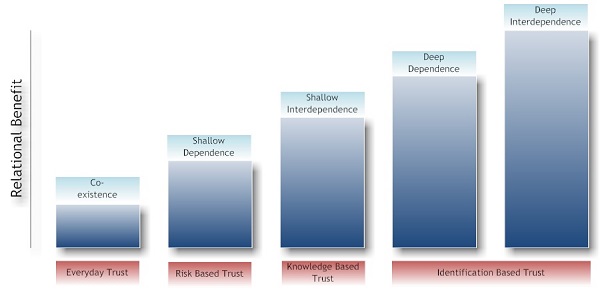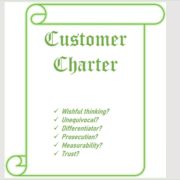Deep Dependence – Part 4
In article three of this series on Interdependence we explored and discussed the third level of Business 2 Business (B2B) customer relational interdependence, that of shallow interdependence. In article four we explore deep dependence. This is an aspect of B2B customer management where most vendors wish they had given more thought to relational development and its implications. At this stage the vendor has developed relationships with a core group of customers in which they have become dependent upon the customers for their value and volume delivery. The balance and onus of trust and equitability is dependent upon the customers.
What do we mean by Deep Dependence?
|
Element |
What do we mean? |
| Deep Dependence | The relationship is determined, influenced and controlled by the core customers. A greater reliance and trust is placed upon the customer for the relationship to remain equitable. |
What do we mean by Identification Based Trust?
| Identification Based Trust | Based on a clear identification with the desires, intentions, values of another to the extent that it is possible to act for, think and feel like the other party. Where this occurs Lewicki and Bunker (1996) suggest that ‘second order learning’ begins to happen. An understanding of what must be done to maintain the other party’s trust is developed and behaviour adjusted accordingly. Identification based trust does not operate in isolation from calculus and knowledge based trust. The processes relevant to these forms of trust contribute towards the creation of identification based trust. Such processes are also supported by four additional types of activities:
|
As the relationship develops the vendor becomes more and more dependent upon the customer or core group of customers for the organisation’s value and volume. In many instances we find individual customers accounting for circa 30 to 40 % of the organisation’s business as they become business critical. As the vendor struggles to maintain the relationship the balance of trust and reliance swings in the favour of the customer and often leads to margin erosion or inequity. Unfortunately, this is where many vendors get stuck within a cycle of holding onto business with decreasing levels of value or at any cost as they aim to maintain the volumes/production and or operational efficiencies.
It is worth noting that not all vendors working within Deep Dependence relationships suffer from the above. They will be employing a strong commercially orientated customer management approach. This is often typified through high levels of capability and competency within the customer management team around strategic and everyday negotiation and value based selling supported through strong customer and contact planning.
An example of what we mean, a relationship had developed over 10~11 years to a point where 45% of the business was coming through one customer. During the intervening period, the customer had driven enhanced value for the vendor mainly through refusing price increases and supply chain cost release often at the vendor’s expense. Through the customer’s eyes the relationship was fine. Equitability loss was justified within the vendor through continued business and fear of losing 45% of the business. The tipping point occurred at a ‘head to head‘ review aimed at balancing the equitability of the relationship. This was achieved through the offer of value reward offered based upon growth objectives that were mutually shared and agreed. This proved a game changer and moved the relationship into one of Deep Interdependence.
Knowledge
Are the values and culture of the organisation clearly demonstrated and do they closely match those of your key customers? You will often find key elements of Identification Based Trust and move towards Deep Dependence is one of shared values and similar cultures. This we refer to as ‘socialisation selection’. In essence you have selected to deepen the relationship with each other based upon shared values and culture. This can be leveraged to deepen a relationship with a core customer.
Which type of communities to share, either on-line or more formally within trade bodies/organisations? Which type of partnership is in operation with key customers, is it one way or a truly shared relationship for mutual value? These elements working in combination will develop a sense of community between vendor and key customer.
Strategy
Customer complexity is often a key factor of large customers. Meeting customer complexity with wiring plans that match the organisation’s resources and functions to influence and manage the customer stakeholders is a prerequisite. These can be in the form of virtual teams or functional champions responsible for customer contact, nominated stakeholder influencing and management. Often developed against a strategic contact plan aimed at penetrating the customer’s organisation.
When dependent upon key customers, an essential element is the ability to react rapidly and effectively to information requests, service issues and relational disquiet. This often drives fire fighting tactical behaviours within customer management teams and a loss of strategic focus. Customers in this relational space will look to vendors for solutions to address challenges and issues they face as a key differentiator.
Planning
A significant element of deeply dependent relationships is reflected within the integrity of the interaction that takes place between both parties on a daily basis. When so much is often at stake, it can be tempting to bend the truth or accuracy of information to placate a potentially difficult situation, e.g delivery dates and time is a prime example where information may be offered that is less than accurate in an attempt to solve the issue ‘in the moment’. When the customer then complains about the missed slot, this is once again covered by a small untruth ‘the truck was stuck in traffic’, etc. Continued use of these mechanics will undermine relational integrity over time. Integrity can be developed by ensuring interactions with your customers are accurate, and broadly truthful.
Implementation
It is not uncommon for vendors to co-locate staff within customer’s offices when operating within highly dependent relationships. This not only demonstrates an obligation to the relationship for the vendor, it offers the potential to penetrate the customers organisation.e.g. 50 to 60 project managers within the customer all of whom have the potential to deliver value enhancing projects for the vendor. A sales man co –located within the customer has the potential to network with the 50 to 60 project managers from within the customers organsdiation, turning a passive and reactive process into a highly proactive relationship.
Results
The ability to share common measures and language is a common factor within these types of relationships. It is not unusual to find the customer setting the mechanism that controls the relationship in terms of performance and financial metrics. This is often manifested within OTIF, PPM, wastage, % margin, lead-times, category 5 corridors, promotional investment, etc, to name but a few. In this instance it is important for the vendor to introduce some customers controls into the relationship to provide a certain level of balance.
So, what are the potential downsides?
- The customer exploits the position of dependence to extract increasing levels of margin
- The relationship becomes adversarial.
- Increased customer demands force customer service resources into tactical short term fire fighting.
- Trust levels within the relationship become undermined over time.
- Over dependency within one division or category may mask an interdependent relationship within another division.
- Unless reviewed on a regular basis the relationship can erode the long term viability of the vendor.
- Increasing customer demands are increasingly difficult to achieve through an inability to invest exasperated through customer margin and investment requirements.
So, what are the potential upsides?
- Provides the platform for the development into deep interdependence
- Vendors improve their commercial skills.
- Deep dependency customers could offer operational efficiencies through scale.
- Access to scale for product, proposition and business development.
- Lever relational trust to build equitability.
- Can be an enabler for staff co-location, often seen as a catalyst for relationship development, especially within trust and interdependence.
- Deep dependency doesn’t only run one way and can provide the basis for strategic partnership development.
In article five, we discuss how the customer management relationship can move from deep dependence and into deep interdependence, often seen as strategic partnership or ‘bonded relationship’.
- Excessive Trust – When Trust Goes Wrong - October 29, 2024
- Identification Based Trust - October 21, 2024
- Introducing Knowledge Based Trust - October 15, 2024




